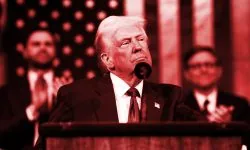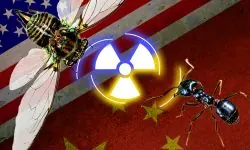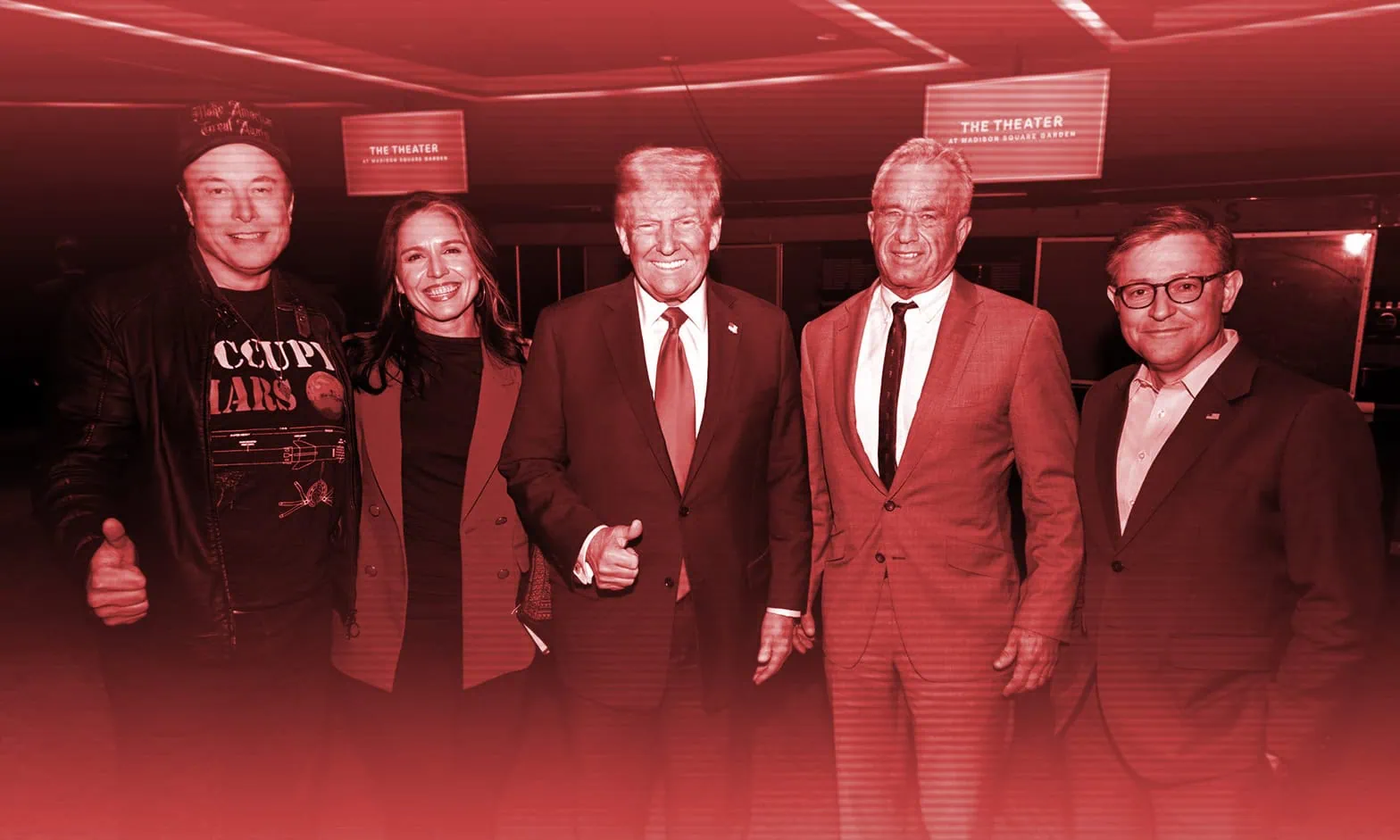(Donald Trump avec Elon Musk, Tulsi
Gabbard, RFK Jr, et Mike Johnson
Crédit photo : du bureau du président de la Chambre des représentants
Mike Johnson - Domaine public )
Le président élu Donald Trump a déclaré que le Canada devrait devenir le "51e État" des États-Unis d'Amérique. Il répète également assez souvent que les États-Unis devraient "acheter le Groenland" (Alexandra Sharp, "Til 51st Étoile du drapeau américain ?”, Politique étrangère, 19 décembre 2024 et Anthony Slodkowski et James Pomfret, "L'offre de Trump sur le Groenland suscite un débat en Chine sur le sort à réserver à Taïwan”, Reuters, 15 janvier 2025).
Pendant ce temps, Elon Musk, le techno-industriel multimilliardaire et conseiller de Donald Trump, a eu une rude polémique avec Justin Trudeau, le Premier ministre démissionnaire du Canada, via Twitter/X. (Anushree Jonko, "Musk se moque de Justin Trudeau à propos de l'idée de fusion entre le Canada et les...””, NDTV, 8 janvier 2025.
- Géopolitique de Trump (2) - La guerre géoéconomique entre les États-Unis et la Chine

- L'IA en guerre (4) : La course aux drones et aux robots entre les États-Unis et la Chine

- Comment utiliser l'IA pour les signaux faibles - Trump, le révolutionnaire international ?

- 2ème session de la 5ème année de formation avancée en systèmes d'alerte précoce et indicateurs - ESFSI de Tunisie

- DeepSeek vs Stargate - L'offensive chinoise contre la domination américaine en matière d'IA ?

- Géopolitique de Trump - 1 : Trump, le président du pouvoir de l'IA

- De l'uranium pour la renaissance nucléaire américaine - 2 : Vers une course géopolitique mondiale

Ces déclarations ont eu lieu pendant la transition présidentielle. L'équipe de transition est dominée par un réseau de personnalités de haut niveau du secteur de la tech et de l'IA. C'est le cas, par exemple, de David Sacks, investisseur massif dans la tech qui est le "Crypto and AI Czar" de l'équipe de transition ("Crypto and AI Czar").Qui est qui dans l'entourage de Trump dans la Silicon Valley ?", BestofAI, via Financialpost.com, 19 décembre 2024).
Il faut également noter que le vice-président J. D. Vance a un passé d'investisseur en capital-risque dans le monde des affaires technologiques. Il est notamment proche de Peter Thiel, l'un des plus puissants milliardaires de la technologie, fondateur de Palantir (Erin Mansfield, "Peter Thiel et JD Vance : Comment le fondateur de Paypal a stimulé la carrière politique du candidat VP”, USA Today17 juillet 2024).
Ce réseau, qui représente des intérêts massifs en matière de technologie et d'IA, semble être très actif dans le premier cercle du président élu. Ils plaident tous pour une forte diminution des réglementations pour les questions liées à la technologie, ce qui devrait concerner également l'IA et les crypto-monnaies (Carl Zakrzemwski et Jacqueline Alemani, "Musk n'est pas le seul dirigeant du secteur technologique à contribuer à l'élaboration de l'administration Trump.“, Le Washington Post, 13 janvier 2025 et Theo Burman, "L'orbite technologique de Donald Trump - Comment la Silicon Valley a fusionné avec MAGA”, Newsweek, 13 janvier 2025).
Comme nous le verrons, la confrontation de ces déclarations et des intérêts de la communauté de l'IA révèle certains des principaux moteurs des orientations politiques de la présidence Trump.
Le Groenland et le Canada sont d'une importance cruciale pour le développement de l'industrie nationale de l'IA. En effet, le développement extrêmement rapide de ce secteur consomme des ressources énergétiques et minérales croissantes.
L'identification du Canada comme cible stratégique de sa politique étrangère est donc parfaitement logique d'un point de vue stratégique (Minéralisation en terres rares au Groenland, Eurare).
Il en va de même pour le Groenland, afin d'acquérir les terres rares nécessaires à la construction d'ordinateurs d'IA (voir également Lavoix, "De l'uranium pour la renaissance nucléaire américaine (2) : Vers une course géopolitique mondiale"). Elle pourrait également réduire la dépendance des États-Unis à l'égard des importations de terres rares chinoises (Nigel Inkster, Le grand découplage : La Chine, l'Amérique et la lutte pour la suprématie technologiqueHurst, 2021).
Nous émettons donc l'hypothèse que les lignes directrices du président Trump concernant le Canada et le Groenland sont également celles de la définition de l'intérêt national des États-Unis selon l'IA/les ressources stratégiques au début de sa présidence.
Dans cet article, nous examinerons la manière dont l'intérêt de la présidence "Trump II" pour le développement de l'IA s'enracine dans les réseaux de pouvoir de la Silicon Valley ainsi que dans la dynamique de développement du secteur de l'IA. Ensuite, nous soulignons que les déclarations sur le Canada et le Groenland révèlent l'intérêt croissant du secteur de l'IA pour les ressources énergétiques et minérales. Enfin, nous étudions ce que ces évolutions signifient en termes géopolitiques et stratégiques pour la "puissance de l'IA" américaine.
Donald Trump II et l'IA
Nous sommes une famille f.AI.mily
La seconde campagne présidentielle de Donald Trump semble avoir été fortement soutenue par une partie de l'industrie technologique, dont l'IA, et certaines de ses principales figures. Parmi eux, le réseau de Peter Thiel semble assez important.
Peter Thiel est le cofondateur de PayPal avec Elon Musk. Il a également fondé Palantir avec Alex Karp, tout en bénéficiant du soutien d'In-Q-Tel, l'entreprise fondée par la CIA ("Palantir Technologies, soutenu par la CIA, lève $107,8 millions d'euros”, Reuters, 11 décembre 2013, Sharon Weinberger, "Palantir, la licorne la plus effrayante et la plus secrète du Big Data, entre en bourse. Mais sa boule de cristal n'est-elle que de la poudre aux yeux ?”, New York MagazineLe 28 septembre 2020, Shoshana Zuboff, L'ère du capitalisme de surveillance, La lutte pour un avenir humain à la nouvelle frontière du pouvoirLondres, Profile Books, 2019 et Kenneth Payne, Moi, Warbot, l'aube d'un conflit artificiellement intelligentLondres, Hurst, 2021.)
Marc Andreesssen est une autre figure majeure du réseau. Il est un investisseur majeur dans des entreprises de la tech et de l'IA, par exemple AirBnB, FaceBook ou Coinbase entre autres. Marc Andreessen semble être un recruteur actif pour l'administration Trump (Sarah Mac Bride, "Voici la liste des leaders de la technologie qui rejoignent le nouvel entourage de Trump dans la Silicon Valley", de Bloomberg,, Business Standard, 20 décembre 2024).
Si Microsoft, Facebook et Amazon n'ont pas été très loquaces à l'égard de Donald Trump pendant la majeure partie de la campagne présidentielle, certains mouvements semblent importants à noter.
Par exemple, Jeff Bezos, multimilliardaire, fondateur d'Amazon et propriétaire du Washington Post, qui penche historiquement du côté démocrate, a ordonné à la rédaction de ne soutenir aucun candidat (Adas Gold et Brian Stelter, "Le Washington Post ne soutiendra pas de candidat à l'élection présidentielle de 2024 après la décision de Bezos“, CNN25 octobre 2024). Ce déménagement a constitué une bifurcation historique pour cet important point de vente.
Après l'élection, le 13 décembre, Sam Altman, PDG d'OpenAI, qui produit Chat GPT, a déclaré que "le président Trump conduira notre pays dans l'ère de l'IA, et je suis impatient de soutenir ses efforts pour assurer que l'Amérique reste en tête" (" ".Sam Altman affirme que Trump "fera entrer notre pays dans l'ère de l'IA" et donne $1 million au fonds d'investiture.”, Fortune, via L'Associated Press13 décembre 2024). Puis, aux côtés de Mark Zuckerberg et de Jeff Bezos, il a également donné un million de dollars au fonds du jour de l'investiture de Donald Trump. (Julianna Kim, Bobby Allin "Les magnats de la technologie Altman, Zuckerberg et Bezos font un don au fonds d'inauguration de Trump”, NPR13 décembre 2024). Parmi les entreprises de technologie / IA, c'est aussi le cas d'Adobe, Alphabet Google, Robinhood et Uber ("Les entreprises américaines s'engagent à faire des dons pour l'investiture de Trump”, Reutersjanvier 2025).
Certains membres de ce réseau technologique feront partie du gouvernement de Trump. Par exemple, David Sacks, ex-employé de Peter Thiel et d'Elon Musk chez Paypal, sera le "tsar de l'IA et de la cryptographie" de la Maison Blanche. Trae Stephens, ex-associé général de "Fonds du fondateur"Le secrétaire d'État à la Défense, Peter Thiel, qui a créé un fonds d'investissement dans les technologies, notamment l'IA, pourrait devenir secrétaire d'État adjoint à la Défense.
Michael Kratsios, ancien chef de cabinet de Peter Thiel au "Founders Fund", dirige la commission technologique pendant la transition présidentielle (Stavroulan Pabst, "Un ami de Thiel et un investisseur en capital-risque envisagé pour 2 anset poste au Pentagone”, L'art politique responsable, 27 novembre 2024 ; Adam Hayes, "Comment la mafia PayPal s'apprête à dominer la nouvelle administration”, Investopedia23 décembre 2024.
Ensuite, il y a le dense réseau de relations entre Peter Thiel venture fund, qui, entre autres, investit dans des sociétés d'Elon Musk, comme la société "new space" Space X ainsi que les constellations de satellites Starlink. Le Founder's Fund investit également dans Palantir et dans Anduril, une société spécialisée dans les drones de combat (Dom Lim, "Le complexe de science-fiction de la Silicon Valley : comment Tolkien, Iron Man et les fondateurs de PayPal façonnent l'avenir de l'IA de défense“, Moyen, 10 novembre 2024).
En fait, ces personnes et les réseaux personnels, corporatifs, institutionnels, politiques et financiers qui les relient représentent littéralement de vastes pans du secteur technologique américain et de l'industrie de l'IA. Il est également intéressant de noter que de grandes entreprises comme, entre autres, Palantir, Anduril, Starlink sont des moteurs de la militarisation de l'IA (Roberto J. Gonzalez, La guerre virtuelle, la quête de l'automatisation des conflits, de la militarisation des données et de la prédiction de l'avenirOakland, University of California Press, 2022).
On pourrait dire que l'omniprésence d'Elon Musk autour de Donald Trump personnifie les interdépendances entre les intérêts croissants des industries de l'IA et de l'intérêt national américain. En effet, Elon Musk fait partie des multiples réseaux qui relient les milliardaires de la technologie de la Silicon Valley, ainsi que leurs industries.
Ces réseaux relient également ces mêmes personnes et industries à la communauté de la sécurité nationale et de la défense des États-Unis ( Jean-Michel Valantin, "AI at War (1) - Ukraine”, The Red Team Analysis Society3 avril 2024). Sachant que la branche militaire est un élément central de l'État, la militarisation de l'IA apparaît également comme une dynamique majeure de son intégration institutionnelle (Ian Morris, La guerre, à quoi ça sert ? Conflits et progrès de la civilisation, des primates aux robotsFarrar, Strauss et Giroux, 2014).
Ainsi, du point de vue de l'analyse de réseau, ces entreprises sont littéralement des nœuds qui relient l'industrie de l'IA au secteur militaire. Elles sont les moteurs de la mise en œuvre industrielle, stratégique et opérationnelle de l'intérêt national américain.
Intérêt national
Comme l'explique Hélène Lavoix, "l'intérêt national américain" est simple. Il s'agit essentiellement de protéger la sécurité du peuple américain (ISSG). Comme l'explique la fiche d'information de la SDN 22, il se décompose en trois intérêts nationaux vitaux pour les États-Unis :
"La protection du peuple américain,
NDS 22 Factsheet " (Hélène Lavoix, "L’intérêt national américain”, The Red Team Analysis Society, 22 juin 2022).
L'expansion de la prospérité de l'Amérique,
La réalisation et la défense de nos valeurs démocratiques".
Aujourd'hui, le premier et le deuxième point de cette liste apparaissent comme étroitement liés au développement du secteur de l'IA.
Croissance
En effet, selon les prévisions de marché de Statista, le secteur américain de l'IA connaît une croissance explosive. Sa taille totale était de 25,65 milliards USD en 2020. Ensuite, elle était de 54,87 milliards USD en 2021 et de 34,67 milliards USD en 2022, qui était une année d'ajustement. Elle a ensuite atteint 37,23 milliards USD en 2023 et 50,17 en 2024. La croissance du secteur américain de l'IA pourrait atteindre 66,21 milliards USD en 2025. Si le secteur continue de croître à ce rythme, il pourrait atteindre 223,61 milliards USD en 2030 ("Intelligence artificielle - États-Unis”, Statistiques).
Ainsi, toujours selon Statista, ce taux de croissance correspond à 1,22% du PIB américain en 2022 à 1,51% en 2023 et 3,23% en 2024. Elle pourrait atteindre 5,13% en 2025. À ce rythme, toutes choses égales par ailleurs, le secteur américain de l'IA pourrait représenter l'équivalent de 14,19% du PIB américain en 2030.
Cette croissance va de pair avec l'augmentation du nombre d'utilisateurs américains. Ils étaient 48,13 millions en 2020, 59,72 en 2021, 75,07 en 2022, 92,78 en 2023, 112,60 en 2024. Par hypothèse, le nombre d'utilisateurs américains de l'IA pourrait atteindre 138 millions en 2025. En 2030, il pourrait être de 241,50 millions de personnes, sur une population totale de 350 millions de personnes (Statista, ibid).
Le mammouth des semi-conducteurs
Ce taux de croissance explosif alimente une demande intense en semi-conducteurs. Cette demande est le moteur de la transformation de Nvidia. Cette entreprise est le principal producteur américain de semi-conducteurs et, en 2024, elle est devenue l'une des deux entreprises américaines les plus précieuses.
Sa valeur de marché a atteint 3,2 billions USD à la fin de 2024, tandis qu'Apple atteint 3,7 billions USD, et Microsoft 3,1 billions USD La demande de puces GPU est si puissante que la croissance de Nvidia a été de 2 billions d'une année sur l'autre. ("La valeur de marché de Nvidia augmentera de 2 000 milliards en 2024 grâce à l'IA”, Reuters, 2 janvier 2025 ; Britney Nguyen, "Nvidia tire près de la moitié de ses revenus de quatre clients. Voici de qui il s'agit”, Quartz23 septembre 2024.
En d'autres termes, le secteur américain de l'IA est en train de devenir un puissant moteur économique. Son rythme de croissance est porté par la particularité même des technologies de l'IA. En effet, ces technologies intègrent tous les secteurs, de l'agriculture aux transports en passant par la robotique, la gestion, la sécurité, l'influence internationale et la guerre (Hélène Lavoix, " Agriculture intelligente, pouvoir international et intérêt national”, The Red Team Analysis Society, 11 avril 2019 et Hélène Lavoix, "Explorer les impacts en cascade avec l'IA”, The Red Team Analysis Society, 17 mai 2023 et "Portail de l'IA - Comprendre l'IA et anticiper un monde intégrant l'IA”, Le Red Team Analysis Society) .
Ainsi, il apparaît que l'implication du secteur de l'IA en faveur de Donald Trump représente également son implication en faveur des orientations politiques de son administration.
Du Groenland et du Canada à l'IA des États-Unis
Dans ce contexte, l'intérêt du président Trump pour le Canada et le Groenland apparaît comme étroitement lié aux besoins de l'industrie américaine de l'IA en matière de production d'électricité et de ressources minérales.
En effet, la croissance rapide des utilisations de l'IA et son ampleur exercent une pression considérable sur les capacités de production d'électricité des États-Unis.
L'écart énergétique
Selon Goldman Sachs, la demande en énergie des centres de données est restée stable. Au niveau mondial, -ces infrastructures consommaient entre 1% et 2% de l'énergie totale. Cependant, cette demande pourrait augmenter de 160% d'ici 2030. Ce pic est intrinsèquement lié au développement de l'IA. En effet, si une recherche Google consomme O,3 watt par heure, une seule requête Chat GPT consomme 2,9 watt-heure d'électricité ("GS Sustain : Croissance générationnelle : L'IA, les centres de données et la prochaine montée en puissance des États-Unis”, Goldman Sachs29 avril 2024).
Toujours selon Goldman Sachs, les centres de données consomment déjà 3% de la production électrique américaine. Cependant, cette demande pourrait atteindre 8% d'ici 2030. Pour répondre à cette demande, les États-Unis devront produire 47 gigawatts de capacité électrique supplémentaire. Ainsi, comme l'établit Hélène Lavoix, le projet d'une "renaissance nucléaire américaine" (Hélène Lavoix, "Vers une renaissance nucléaire américaine ?” The Red Team Analysis Society15 octobre 2024).
Ce taux de croissance est tel que les industries de l'IA, parmi lesquelles Amazon, OpenAI-Microsoft, Google, expriment leur volonté d'acquérir leurs propres réacteurs nucléaires (Darrell Proctor, "Microsoft Would Restart Three Mile Island Nuclear Plant to Power AI“, Power, 20 septembre 2024, Brian Martucci, "Constellation plans 2028 restart of Three Mile Island unit 1, spurred by Microsoft PPA“, Utility Dive, 20 septembre 2024, Darrell Proctor, "AWS Acquiring Data Center Campus Powered by Nuclear Energy“, Power, 4 mars 2024 ; Helene Lavoix, "Vers une renaissance nucléaire américaine ?“, The Red Team Analysis Society).
A ces besoins énergétiques s'ajoutent ceux des usages de l'IA. Leur croissance déstabilise le marché américain de l'électricité, ce qui contribue à la nécessité d'une "renaissance nucléaire" (Lavoix, Ibid.). Ainsi, l'intérêt théorique pour les Etats-Unis d'avoir un meilleur accès à l'uranium, au pétrole, au gaz et à l'hydroélectricité canadiens (Hélène Lavoix, "De l'uranium pour la renaissance nucléaire américaine (2) : Vers une course géopolitique mondiale”, The Red Team Analysis Society 18 janvier 2025).
Dans ce contexte, l'intérêt du président Trump pour le Canada semble ancré dans l'équation américaine croissance de l'IA/demande d'électricité/production d'électricité. En effet, le Canada est un grand producteur d'énergie, à travers l'hydroélectricité, la production de pétrole et de gaz de schiste de l'Alberta, les énergies renouvelables, et ses mines d'uranium (Hélène Lavoix, "L'uranium pour la renaissance nucléaire américaine - 1 : répondre à des besoins sans précédent”, The Red Team Analysis Society, 27 novembre 2024, et Ian Riach, "Les centres de données d'IA sont avides d'énergie et le Canada répond à l'appel”, Fiduciary Trust Canada18 novembre 2024).
L'affaire Eric Schmidt
La traduction des besoins énergétiques émergents de l'industrie de l'IA dans le discours politique prend de nombreuses formes. Par exemple, il convient de citer Eric Schmidt, cofondateur de Google. Lors d'une conférence à l'université de Stanford, il a déclaré que :
" Je suis allé à la Maison Blanche et je leur ai dit que nous devions devenir les meilleurs amis du Canada,.... Parce qu'ils ont... BEAUCOUP d'énergie hydroélectrique et que nous (les États-Unis) n'en avons pas assez... Donc, l'alternative, ce sont les Arabes... mais ils ne vont pas adhérer à nos règles de sécurité nationale... alors que les États-Unis et le Canada font partie d'un continent géant...".
Eric Schmidt, "Pas supprimé une seconde - L'ex-PDG de Google Schmidt a été invité à prononcer un discours (réunion confidentielle).
Il se trouve que l'accès à la Maison Blanche est possible pour Eric Schmidt car de 2018, (pendant la première présidence Trump), à 2021, (pendant la présidence Joe Biden), il a été président du conseil d'administration du Commission nationale de sécurité sur l'IA. À ce titre, il est une voix importante dans le domaine de la co-intégration du secteur de l'IA et de l'État fédéral, de la communauté de la sécurité nationale et de la société civile américaine. Il faut noter que l'une des principales recommandations de la commission est que "le gouvernement américain doit s'engager dans la compétition de l'IA et s'organiser pour la gagner".
Il semble donc possible d'interpréter les déclarations du président Trump sur le fait que le Canada devienne le "51e État" de la fédération américaine comme une "traduction officielle" de l'importance stratégique du Canada pour le développement de l'industrie et de la puissance de l'IA aux États-Unis. Elle traduit également l'inquiétude croissante du secteur de l'IA quant à l'accès à suffisamment d'énergie pour soutenir sa croissance.
Un monde d'IA (très) matériel
Les besoins matériels du secteur américain de l'IA ne se limitent pas à l'énergie. Ce secteur industriel a besoin de quantités massives de minéraux de terres rares. Ces éléments sont essentiels pour produire les semi-conducteurs nécessaires aux ordinateurs d'IA. Toutefois, les principales mines et capacités de raffinage de ces minéraux ont été développées en Chine. Cette situation a créé une dépendance de fait entre les pays et les entreprises qui ont besoin de terres rares et de leur raffinage et la Chine (Inkster, ibid).
Ces minéraux sont indispensables à la production de semi-conducteurs. Ils sont donc d'une importance vitale pour Nvidia, par exemple. Il se trouve que Pékin impose actuellement une interdiction sur les exportations de terres rares ainsi que sur les technologies de traitement des terres rares vers les États-Unis.
Cette décision intervient en représailles à la guerre commerciale et à l'interdiction de technologies imposées par les États-Unis à la Chine, qui s'est intensifiée depuis son lancement par le président Trump en 2018 (Gracelin Baskaran, "Ce que signifie l'interdiction par la Chine des technologies de traitement des terres rares”, SCRS, 8 janvier 2024, et Eduardo Baptista, "Après l'interdiction des exportations de minerais par la Chine, comment celle-ci pourrait-elle réagir autrement à la limitation des importations par les États-Unis ?”, Reuters3 décembre 2024). Cette interdiction met donc en péril le développement de l'IA aux États-Unis, ainsi que l'intérêt national et la sécurité du pays.
Dans ce contexte, lorsque le président élu Trump exprime son intérêt pour "l'achat du Groenland", il convient de noter qu'il existe d'importants gisements de différents éléments de terres rares au Groenland. "Pourquoi le monde se tourne-t-il vers les métaux à base de terres rares du Groenland ?”, Réseau d'actualités sur l'innovation, Innovation News Network, 03 août, 2023).
Il se trouve que le Groenland se trouve dans la sphère juridique euro-danoise. Cependant, le pays fait partie de la sphère de défense américaine depuis 1941. En effet, le Groenland accueille la base aérienne/spatiale de Pittuflik, également connue sous le nom de "base de Thulé".
Ainsi, à l'ère de l'IA, les gisements de terres rares augmentent fortement la valeur stratégique du Groenland pour les États-Unis. Ses déclarations sont la façon dont le président Trump traduit cette dynamique en une ligne directrice politique.
Le président de la puissance américaine en matière d'IA
En d'autres termes, il est très probable que le second mandat du président Donald Trump verra l'intégration stratégique du secteur de l'IA au statut des États-Unis en tant que grande puissance du 21e siècle.
Vers l'État IA
Cette dynamique s'exprime déjà de manière institutionnelle, avec la création du Department of Government Efficiency (DOGE). Présidée par Elon Musk et coprésidée par Vivek Ramaswamy, cette commission consultative présidentielle a pour mission de promouvoir la technologie comme moyen de réduire le nombre d'agences fédérales et d'employés.
La mission principale de la commission est de mener "trois grands types de réformes : les abrogations réglementaires, les réductions administratives et les économies de coûts". Certains des objectifs de la commission sont de redéfinir l'efficacité du gouvernement dans un contexte numérique et technologique en rapide évolution (Ross Gianfortune, "Les réformes proposées par la DOGE sont axées sur la technologie et l'efficacité., GOVCIO Recherche sur les médias, 01/06/2025).
En d'autres termes, le DOGE va (essayer de) mener à la fois l'intégration des technologies actuelles, c'est-à-dire l'intelligence artificielle, à l'Etat fédéral, tout en réduisant la réglementation dans le secteur technologique (Ross Gianfortune, ibid). Ces objectifs semblent d'ailleurs assez clairement alignés sur les recommandations développées par la Commission de sécurité nationale sur l'IA, présidée par Eric Schmidt (Schmidt, ibid, voir ci-dessus).
Ceci suggère fortement qu'il existe des continuités entre les travaux de la commission qui a publié ses résultats en 2021 et le programme de la DOGE en 2024-2025. Cette continuité apparaît notamment dans la mise en commun des objectifs 2021 de la Commission qui énoncent les besoins de projection du secteur de l'IA dans les institutions gouvernementales ainsi que dans le tissu de la société américaine et la mission annoncée de la DOGE, qui apparaît comme une traduction opérationnelle de ces objectifs.
Vers une escalade géopolitique de l'IA ?
Il ne faut pas oublier que ces objectifs s'inscrivent dans le contexte d'une militarisation et d'une militarisation rapides de l'IA. L'un des moteurs de cette dynamique est la demande de technologie de l'armée américaine. La concurrence avec la Chine, l'autre grande puissance, en est un autre. Et la Chine mène également une "intelligentisation" rapide de ses forces militaires (Jean-Michel Valantin, "AI at War (2) - Se préparer à la guerre entre les États-Unis et la Chine ?”, The Red Team Analysis Society17 septembre 2024).
Ainsi, la seconde présidence Trump pourrait très bien être considérée comme la structure politique qui va produire la forme américaine du pouvoir politique et de la gouvernance de l'IA. Cela pourrait se produire en canalisant la révolution de l'IA dans le fonctionnement même du gouvernement fédéral
Cette canalisation de l'IA imprègne déjà le processus de définition des États-Unis en tant que grande puissance géopolitique. Ainsi, cette dynamique pourrait devenir la version politique américaine de ce qu'Hélène Lavoix définit comme le pouvoir de l'IA dans un monde d'IA (("L'intelligence artificielle au service de la géopolitique - Présentation de l'IA”, The Red Team Analysis Societyle 27 novembre 2017).
Il faut maintenant voir comment la puissance de l'IA américaine va interagir avec ses alliés et ses ennemis.



Merci à l'auteur ; l'article semble être une analyse approfondie liant les politiques de Trump aux avancées technologiques.